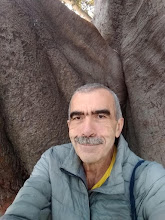Quantum computer is
discussed in papers both as a mathematical model and as its technical
realization. Only the mathematical model is meant here and in
comparison with that of a standard computer, namely a Turing machine.
The quantum Turing machine is an abstract model equivalent to the
quantum circuit and can represent all features of quantum computer
without entanglement.
Another way to
generalize the Turing machine to the quantum computer is by replacing
all bits or cells of a Turing tape with “quantum bits” or
“qubits”. A qubit is equivalently representable by a unit sphere
and a point chosen on its surface. Then if any bit is an elementary
binary choice between two disjunctive options usually designated by
“0” and “1”, any qubit is a choice between a continuum of
disjunctive options as many as the points of the surface of the unit
ball. That visualization allows of highlighting the fundamental
difference between the Turing machine and the quantum computer: the
choice of an element of an uncountable set necessarily requiring the
axiom of choice.
The term of “quantum
invariance” can be coined to outline the important role assigned to
the axiom of choice in the theory of quantum computer and inherited
from quantum mechanics: The theorems about the absence of hidden
variables in quantum mechanics exclude any well-ordering before
measurement, but the results of the measurements are always
well-ordered and thus any quantum model implies the well-ordering
theorem equivalent to the axiom of choice. However quantum reality
according to the cited theorems is not well-orderable in principle.
Thus the relation between quantum model and quantum reality requires
correspondingly the axiom of choice and its absence or the coined
quantum invariance to designate that extraordinary relation between
model and reality specific to quantum mechanics and trough it, to the
theory of quantum computer. That quantum invariance is well known in
mathematics in the form of Skolem’s paradox, who has introduced the
notion of “relativity” as to set theory discussing infinity.
Quantum invariance
as to quantum computer can be exhaustedly described by the mapping of
quantum computer on a Turing machine. The offered above visualization
of quantum computer as a tape of qubits is about to be used: Any
qubit of it being a choice of one between a continuum of disjunctive
options can be replaced by a Turing machine (possibly with a tape
consisting of infinitely many cells) utilizing the axiom of choice
for replacing. Furthermore quantum invariance states the equivalence
after that replacement.
Given all that, any
quantum computational process can by defined in terms of a standard
one on a Turing machine as infinite but convergent. The limit, to
which it converges, is the result of this quantum computation. It
involves the notion of actual infinity since the computational series
is both infinite and considered as a completed whole by dint of its
limit.
As the model of a
Turing machine unifies the utilized algorithm with the result
obtained by it, quantum computer can be interpreted both as a
convergently advanced algorithm and a convergently improved result
for the former. If its objectivity is to model a concrete reality by
the computed ultimate result, it coincides with reality unlike any
standard Turing machine which has to be finite and thus there is
always a finite difference between the computed reality and any
completed result of a Turing computation. One can state that quantum
computer calculates reality or that quantum model and reality
coincide.
The offered model of
quantum computer on a Turing machine as a convergent and infinite
process comprises the more general case where that infinite process
does not converge and even has infinitely many limit points. One can
use the granted above axiom of choice to order the limit points even
being infinitely many as a monotonic series, which necessarily
converges if it is a subset of any finite interval, and to accept
this last limit as the ultimate result of the quantum computer.
The axiom of choice
can be used in another way to give the same result thus elucidating
the physical and even philosophical meaning of Hilbert space, the
basic mathematical structure of quantum mechanics:
Any qubit represents
equivalently a limit point of the “tape” of the Turing machine,
on which the quantum computer is modeled. If those limit points are
even infinitely many, they can be represented equivalently by a point
in Hilbert space where any “axis” of it corresponds one-to-one to
a qubit ant thus to a limit point of the quantum computational
process. Then obviously any state of any quantum system being a wave
function and a point in Hilbert space can be interpreted as a quantum
calculative process, and the physical world as a whole as an immense
quantum computer.
Using the axiom of
choice, one can always reorder monotonically a bounded set of limit
points to converge or represent a point in Hilbert space as a single
qubit by the Banach-Tarski paradox: Both are only different images of
one and the same quantum computation.
The model of quantum
computer on a Turing machine allows of clarifying the sense and
meaning of a quantum computation in terms of a usual computer
equivalent to some finite Turing machine: While the standard computer
gives a result, the quantum computer offers a tendency comprising a
potentially infinite sequence of converging algorithms and results as
well as the limit of this tendency both as an ultimate
algorithm-result coinciding with reality and as an image (“Gestalt”)
of the tendency as a completed whole.
The transition from
the result of a usual computer to the ultimate result of quantum
computer is a leap comparable with human understanding and
interpretation to restore the true reality on the base of a finite
set of sensual or experimental data.
The paper
The presentation (PDF) (PowerPoint) (Video) or as slides @ EsyChair

No comments:
Post a Comment